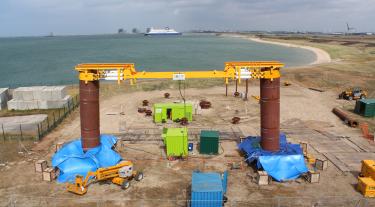Successful field-testing validation of these bespoke methods suggests that previous approaches under-estimate the support that the seabed soil provides to the foundation, resulting in over-conservative design calculations for monopiles.
Estimates suggest that these more accurate methods have the potential to reduce steel requirements for foundations by up to 30 percent for some design conditions, realising significant cost savings.
The new design methods are the outputs of the award-winning Pile Soil Analysis (PISA) project, a £3.5 million joint industry research project (JIP) led by Ørsted and run through the Carbon Trust’s Offshore Wind Accelerator programme. The Academic Working Group was led by Oxford University, and involved Imperial College London and University College Dublin.
Previous estimates for the behaviour of wind turbine foundations were based on offshore oil and gas platform design methods, where the foundation piles are smaller in diameter, longer and must resist different loading conditions during use. The new design methods specifically address larger diameter monopile geometries, as well as wind turbine loading conditions, to allow bespoke optimisation of turbine foundations and structures for specific geographic locations.
The field testing, which provided the validation data for the new design model, was undertaken in two locations with characteristics similar to those found in the North Sea; clay conditions in Cowden UK; sand conditions in Dunkirk France. The new knowledge is now publicly available for use by the wind power industry to bring forward new wind farm developments, as demonstrated by Ørsted, who have applied the new methods to their Hornsea windfarm.
Jan Matthiesen, Director, Offshore Wind, the Carbon Trust, commented:
“We believe these new methodologies will have a significant impact on the way industry understands the interaction between soil conditions and monopile foundations. It is the culmination of many years of collaborative work between industry and academia. Replacing models which were originally developed for the oil and gas sector is a critical step in reducing costs even further.”
Byron Byrne, Professor of Engineering Science at the University of Oxford, and Principal Investigator for the PISA Project stated:
“The PISA project is a fantastic example of industry and academia working closely together to solve engineering problems of real significance to the offshore wind industry and pleased to see that all eight papers are now available Open Access through Géotechnique. Dissemination of the work in this way facilitates a wider and more rapid uptake of the new knowledge, not only for wind farm design by the industry but also as a basis for new research initiatives in academia.”
The PISA project was led by Ørsted, with Jesper Skov Gretlund as Project Manager and Miguel Pacheco Andrade as Technical Manager. On the value of the PISA project for the offshore wind industry, Miguel explained:
“The release of the PISA papers by Géotechnique, one of the most prestigious geotechnical journals, is another important milestone for this successful JIP. The PISA framework is now routinely used in design by all major players in the offshore wind power industry, leading to even more efficient and cost effective monopile foundations for offshore wind farms across the globe. The use of the PISA methodology represents a major paradigm shift in offshore geotechnical design. Not only has it led to significant steel savings for monopile foundations, but the use of PISA allows greater confidence in our design calculations.”
The eight PISA papers are now available on Open Access from the Géotechnique journal on the Institution of Civil Engineers’ website www.icevirtuallibrary.com.
The PISA project received technical input and funding support from former Alstom (now GE Renewable Energy), EDF renewables, E.ON (now RWE), Equinor, Iberdrola, innogy, Ørsted, SSE, Statkraft, Van Oord and Vattenfall.*
ENDS
Notes to editors:
*This insert was added 17/04/2020
PISA#1 Site Characterisation
PISA#2 Field testing methods
PISA#3 Field testing in glacial clay till at Cowden
PISA#4 Field testing in marine sand at Dunkirk
PISA#5 Finite element modelling for glacial clay till
PISA#6 Finite element modelling for marine sand
PISA#7: PISA design model for glacial clay till
PISA#8: PISA design model for marine sand
For further information please contact:
The Carbon Trust press office on +44 (0) 20 7170 7050 or email press@carbontrust.com.
About the Offshore Wind Accelerator
The Offshore Wind Accelerator (OWA) is Carbon Trust's flagship collaborative RD&D programme. The joint initiative was set up between the Carbon Trust and nine offshore wind developers in 2008. The current phase involves nine offshore wind developers; these OWA partners account for 76% of Europe’s installed offshore wind capacity. The OWA programme aims to reduce the cost of offshore wind to be competitive with conventional energy generation, as well as provide insights regarding industry standard (and best practice) health and safety requirements.
The Carbon Trust's OWA industrial partners are nine international energy companies EnBW, RWE, Equinor, Innogy, Ørsted, Scottish Power Renewables, Shell, SSE, and Vattenfall Wind Power.
About the Carbon Trust
Established in 2001, the Carbon Trust works with businesses, governments and institutions around the world, helping them contribute to, and benefit from, a more sustainable future through carbon reduction, resource efficiency strategies, and commercialising low carbon businesses, systems and technologies.
The Carbon Trust:
- works with corporates and governments, helping them to align their strategies with climate science and meet the goals of the Paris Agreement;
- provides expert advice and assurance, giving investors and financial institutions the confidence that green finance will have genuinely green outcomes; and
- supports the development low carbon technologies and solutions, building the foundations for the energy system of the future.
Headquartered in London, the Carbon Trust has a global team of over 200 staff, representing over 30 nationalities, based across five continents.


